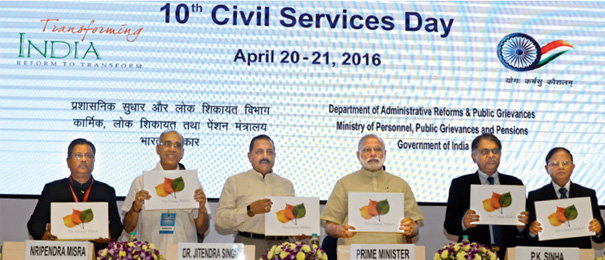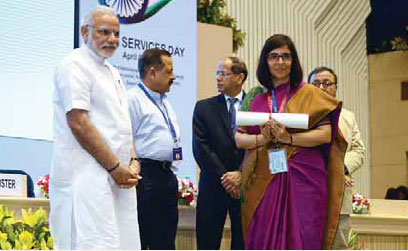
Name of the Initiative
‘Save the Girl Child’ to prevent foeticide
Name of the Awardee
Dr Darez Ahamed
District Collector / District
Magistrate, Perambalur District, Perambalur, Government of Tamil Nadu
Project in Brief
-
- Perambalur District is one of the most backward districts in Tamil Nadu, with the lowest per capita GDP in the state, and a predominantly agrarian society with 83 per cent of the population living in rural areas.
- The literacy rate is 74.68 per cent-male 83.39 per cent and female 66.1 1 per cent with a gender gap of 16.5 per cent (Census 2011).
- There was a sharp decline in the sex ratio (number of female children born as against 1,000 male children) at birth in recent years. It declined from 965 in 2007-08 to 851 in 2010- 11.
- An action plan was drafted to study the situation and work towards achieving the goal of improving the declining sex ratio at birth. The project was named ‘Save the Girl Child’.
- The project aimed at arresting and reversing the decline in sex ratio at birth using a multi-pronged strategy, which the Pre-Natal Diagnostic Techniques (PNDT) Act was not able to achieve.
- The project was initiated in August 2011 and has been running ever since.
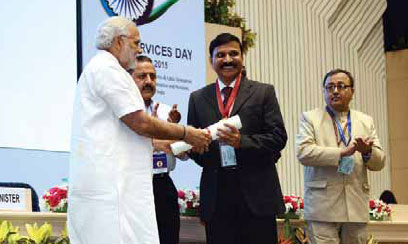 Highlights
Highlights
-
- Early ante-natal care registration.
- All second trimester abortions were audited with regard to whether the abortion was spontaneous or done after sex determination.
- All male births were audited to ascertain whether they had done sex determination. This audit yielded positive results since the parents were more forthcoming in identifying the scan centres.
- Health Sub-Centre served as a unit of intervention.
- Mapping of Health Sub-Centre-wise sex ratio was done and specific intervention planned, depending on local problem identification.
- Areas where abortion was found rampant were brought under continuous surveillance.
- Regular follow-ups were done and constant vigil of all pregnant women was maintained by field-level functionaries.
- Multi-pronged and multi-departmental approach was used to create awareness, prevent sex determination and sex-selective abortion through campaign mode-with PHCs, doctors and VHNs playing an anchor role-guided and monitored by the district collector.
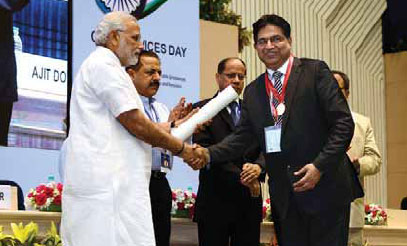 Impact
Impact
-
- The average sex ratio in the district improved from 861 in March 2012 to 1016 by March 2013.
- Second trimester abortion cases were reduced to less than 20 from an average of 45 per month.
- Maternal Mortality Rate of the district was reduced by 50 per cent-to 72 in 2012-13 as compared to 152 in 2011-12.
Name of the Initiative
Hum Chhuyenge Aasman, Madhya Pradesh
Name of the Awardees
Vikas Khararkar
District Sports & Youth Welfare Officer
Jameel Ahmad
Assistant Administrator, State Sports Academy, Gwalior
Project in Brief
-
- Women in Madhya Pradesh, particularly those in the tribal areas, have tremendous potential to excel in sports. But the lack of adequate opportunities, sophisticated coaching tools and women-friendly environment had limited women’s participation in sports.
- This initiative provides socio-psycho-spiritual, educational and economic empowerment of women through excellence in sports. This is done by providing scientific training through expert coaches; improving health through balanced nutritional diet; free formal education to create employment opportunities; attractive prize money; and assured government jobs to athletes of eminence.
- The project covers female athletes from all the 50 districts in the state. The selected women athletes are brought to the sports academies for skill development.
- As a result, the state is today able to provide a safe and secure women-friendly environment. It is also substantially contributing to the country’s medal tally in various international competitions.
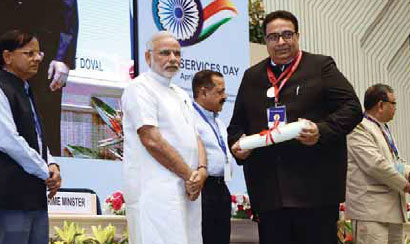 Highlights
Highlights
-
- Massive talent search conducted all over the state and intensively in tribal areas.
- Wide publicity done for prospects and possibilities in sports.
- Sports training linked with education and employment. Prize money doubled for the winners of state awards, national and international games and championships. ‘Khiladi Kalyan Kosh’ created for any exigencies. All boarding athletes provided with free formal education and athletes with outstanding eminence provided with government jobs.
- Software support provided for talent search and coaching.
- Athletes provided with balanced nutritional diets based on experts’ recommendations, regular medical check-up and medical insurance.
- Existing academies upgraded to world-class standards and new ones created to tap tribal potential.
- World-class equipment and playing kits provided for athletes.
- Rigorous and intensive world-class coaching provided.
- Exposure to national and international tournaments provided.
- Winning skills inculcated in athletes through motivational and psychological training.
- Women-friendly environment created for athletes.
- Collection, compilation, analysis and synthesis of reports done for individuals/groups.
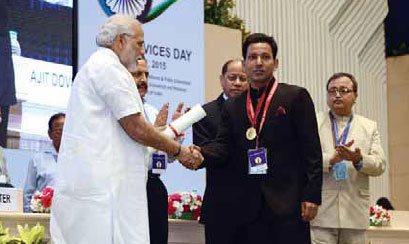 Impact
Impact
The initiative has resulted in improving women’s participation in sports, achieving qualitative and quantitative results, creating employment opportunities and inculcating a winning mindset amongst women athletes.
Name of the Initiative
Sakala; No More Delays-We Deliver on Time
Name of the Organisation
Department of Personnel & Administrative Reforms, Government of Karnataka
Project in Brief
The government of Karnataka has taken the initiative for the enactment and implementation of the Karnataka Guarantee of Services Act 2011 (now called the Karnataka Sakala Services Act). The Sakala Act has 375 services in its ambit and is applicable to the entire State, covering 33 departments and sub-departments. It has the highest number of services being rendered in the country. Over 3.19 crore citizens have availed of the services with a near 98 per cent success rate on time delivery, in a span of 15 months.
Highlights
-
- Pro-active engagement of citizens.
- Ownership by government employees: Extensive discussions and deliberations were held with government functionaries and their associations to convince them about the benefits of implementing the Sakala Act and improving their “brand image”.
- Performance agreements: Bottom-up planning done for choosing the services and preparing workflow charts to map the time taken by each government servant for processing various steps in providing the service ensured. This is to ensure that the administrative system is geared up to deliver much before the stipulated time.
- Upgrading capacity and infrastructure: A detailed training plan was drawn up with the help of Administrative Training Institute, Mysore, to train 16,000 designated officials on the roles and responsibilities devolved by the Act as well as the rules and regulations prescribed under the new dispensation. This has been envisaged as an ongoing process.
- Transforming work culture: E-governance is a catalyst in the implementation. The portal-www.sakala.kar.nic.in-provides a seamless interface between the citizen and the government official to receive, process, deliver and monitor the services as per a pre-designed format.
- Management by objectives: Effective monitoring is the key to successful implementation of this project. A dedicated mission team is formed to monitor and track the programme progress. Besides, the alerts on pendency, defaults and so on are automated, thus focusing on the areas of concern.
- Multi-pronged communication strategy: Over 1,600 street plays were enacted all over the state. Interactions with consumer forums, resident welfare associations, the student community as well as women self-help groups and other NGOs were carried out to spread awareness about the Act.
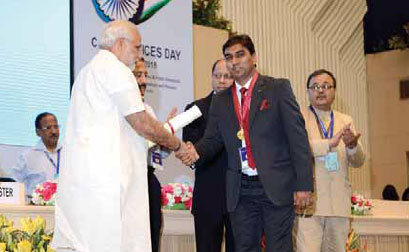 Impact
Impact
Improvement in delivery time of services, better beneficiary/citizens’ feedback and improvement in measurable indicators.
Name of the Initiative
Crop Pest Surveillance and Advisory Project for pest management for major crops in Maharashtra
Name of the Organisation
Commissionerate of Agriculture, Government of Maharashtra
Project in Brief
The project was undertaken after a severe pest outbreak on soybean crop during 2008-09 in Maharashtra, resulting in crop losses over an area of 9 lakh hectares and causing losses worth Rs. 1,392 crore. A team of experts deputed by the Government of India gave its observations and recommendations and an initiative was taken by the Commissionerate of Agriculture in technical collaboration with NCIPM, New Delhi, to formulate a long-term strategy to deal with such situations. For the first time in the country, a multi-stakeholder project, involving national crop research institutes, state agriculture universities and the State Department of Agriculture, was prepared and implemented through the Rashtriya Krishi Vikas Yojana. Scientific pest monitoring on real-time basis was for the first time made possible in the country. The project covers the entire area-112.19 lakh hectares-under rice, soybean, cotton, tur and gram crop.
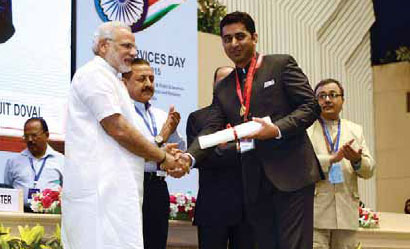 Highlights
Highlights
-
- Software was developed to analyse the data online.
- Effective use of ICT was made for rapid data transmission and issue of advisories to farmers.
- Considering the multi-tasking nature of duties of departmental staff, 835 pest scouts and 84 data entry operators were appointed on contractual basis for the project.
- Connectivity was provided to all the stakeholders. Software and technical training was imparted to the field staff.
- Observations were recorded every Monday-Tuesday and Thursday-Friday from fixed plots and some random plots. Every Wednesday and Saturday, online data entry was done. Analysed data was made available online to experts to help them assist field officers. SMS messages of measures to be adopted were sent to farmers every Thursday and Monday.
- Detailed advisories were pasted at gram panchayat and publicised via print and electronic media.
- Weekly village-level meetings were conducted to guide the farmers.
- Pesticides were supplied on 50 per cent subsidy wherever the pest situation was above accepted norms.
- Rigorous monitoring was done at all levels.
- Pest population data was superimposed on weather parameter data through GIS maps to develop correlation of pest population dynamics for developing pest forecasting models.
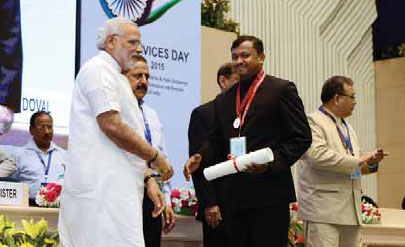 Impact
Impact
Since inception of the project there has been no outbreak of any major pests on selected crops. The number of farmers enrolled for the SMS service has doubled, advisories issued have increased by 4.63 times, number of sent SMS messages have increased by 11.3 times and the shift towards the use of bio-pesticides has increased by 1.57 times.
Name of the Initiative
IT Consolidation Project of CBEC
Name of the Organisation
Directorate of Systems, Central Board of Excise & Customs (CBEC), Department of Revenue, Ministry of Finance
Project in Brief
The Directorate of Systems, CBEC, has implemented a consolidated IT infrastructure to host all its IT-enabled services across customs, central excise and service tax from a central data centre. This infrastructure has enabled high-quality IT services for taxpayers, other external stakeholders and internal users. The highlight is a standardised, stable and secure IT platform, compliant with ISO 27001 standards for information security and using the best practice framework of IT service management as embodied in Information Technology Infrastructure Library (ITIL).
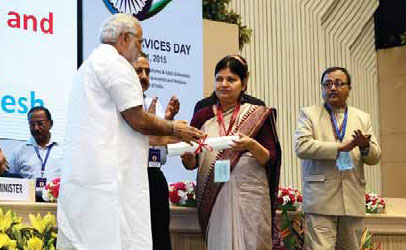 Highlights
Highlights
There was a strong business case for IT Consolidation in CBEC as there was a clear need for a central, standards-driven, professionally managed IT service, leaving field offices free to attend to their core business activities. Some of the key tenets of the strategy adopted by CBEC include:
-
- Commitment from the top: A major success factor of this initiative has been the support it received from the Ministry of Finance, senior government officials, CBEC board and officers at the Directorate of Systems (DoS) and commissionerates.
- Process-oriented and structured framework: CBEC adopted ITIL as its governing framework for this project.
- Role of CBEC officials: Every sub-component of the project is managed and monitored by CBEC officials. The chief information security officer and the information security officer are career IRS officers
- Effective communication and training programmes: About 20,000 personnel were trained on Change Management and more than 100 on ITIL. Some senior officers are ITIL experts and are certified for COB IT, TOGAF, CISA and SAS.
- Robust monitoring and evaluation framework: Measurable and meaningful KPIs have been defined to monitor and measure programme objectives and its achievement, reviewed on a quarterly basis by senior management.
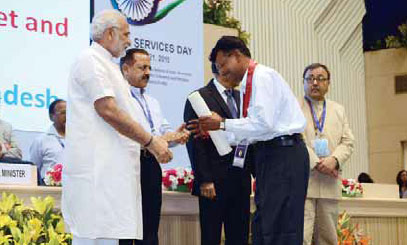 Impact
Impact
The project has touched stakeholders across the categories of taxpayers, departmental officials and other government officials (across ministries / departments). There has been a significant enhancement in service delivery and transparency in operations. It provides a 24×7 window of services, alongwith provision for business continuity and transparency for the taxpayer and CBEC users.
The initiative has brought the benefits of standardising processes and their governance, cost benefits, enhanced security, reduced manual dependence, higher service availability, and improved compliance and reporting. Enhanced reporting and data exchange one achieved through an integrated data warehouse and business intelligence system.
Name of the Initiative
Easy Tax Compliance through Quality Services
Name of the Organisation
Central Board of Direct Taxes, Department of Revenue, Ministry of Finance
Project in Brief
The project focuses on the processes that have helped the Income Tax Department in realising the objective of providing a ‘non-intrusive tax administration’ for the taxpayer. The end-to-end e-enabled services provided are:
-
- E-payment of taxes
- E-filing of TDS statements
- E-processing and tracking of TDS statements
- E-view of tax credits
- E-filing of I-T returns
- E-processing of I-T returns
- E-matching of tax credits
- E-tracking of processing of the income tax returns
- E-delivery of refunds
- E-tracking of the refunds
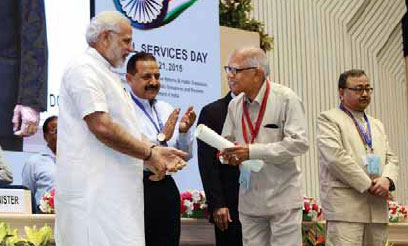 Highlights
Highlights
The strategy was:
1. To establish a central information base which could consolidate, against each taxpayer, all the tax paid directly by himself and the TDS by all the deductors on his behalf. This required necessary administrative, legal, computing and communication infrastructure to facilitate uploading information in TDS statements by deductors and uploading of challan level information by the collecting banks to the central system.
2. To develop a platform to file income tax returns that facilitates filing on an anywhere and anytime basis. Since in the first step, information on tax payments pertaining to a PAN has been made available in the tax system, the matching of tax credits was possible without attaching physical documents.
3. To provide robust platform that ensures compliance on the part of the deductors on one hand and ensures correctness, completeness and reconciliation of tax credits for the deductees. Since nearly 40 per cent of direct tax revenues come through tax deduction by the deductors, a Centralised Processing Cell (TDS) at Vaishali has been developed.
4. To facilitate speedy processing of e-filed income tax returns since the delay in processing leads to increased administrative costs and increases taxpayer grievances. The positive impact of speedy processing inspires taxpayers’ confidence in the tax administration and has a positive effect on compliance.
5. To eliminate the physical writing of refund cheques. Delivery of all refunds be automated through a technology-driven process. Refund banker scheme was launched. Besides saving time and manpower, it also increased taxpayer confidence.
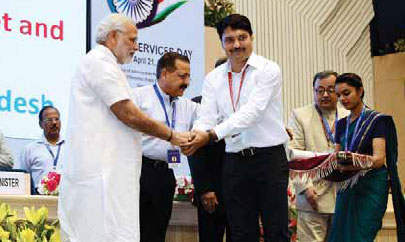 Impact
Impact
-
- Improvement in the delivery time of services
- Strengthening of the tax administration
- Improved tax administration
- Tax information network
- E- payment of taxes
- Centralised processing cell (tds)
- E-filing of tax returns
Name of the Initiative
Rationalisation of affidavits for reforming the public service delivery system
Name of the Organisation
Department of Governance Reforms, Government of Punjab
Project in Brief
The project aims at rationalisation of affidavits for reforming public service delivery. Affidavits were required in support of facts given by the applicants for issue of various certificates, (residence, etc.). Affidavits are affirmations by the applicants (supported in some cases by third parties) and imposed their own cost-buying stamp paper, locating a deed writer, payment to the notary for attestation and, of course, the time and effort consumed in these processes. However, affidavits have no particular sanctity in law and the same function can be easily performed by declarations. In Punjab alone, it is estimated that at least half the households file affidavits annually for one service or the other. Extrapolating this figure to India , the total number may be more than 20 crore citizens/affidavits. Assuming a cost of Rs. 400 per affidavit (one day’s wages plus stamps, fees and charges), the total expense would be about Rs. 8,000 crore.
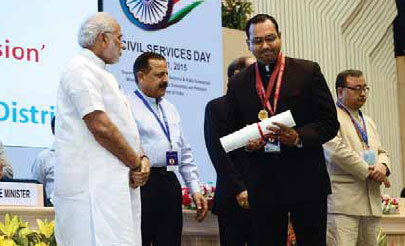 Highlights
Highlights
-
- Innovativeness of the initiative and its replicability: Before starting the practice of self-declaration, affidavits were required for various citizen-centric services like residence certificate, issuance of ration card, etc. The new self-declaration practice has reduced the time, effort and costs of the citizen.
- Increased efficiency of outputs/processes and effectiveness of outcomes: Number of applications regarding affidavits has been reduced at Suwidha centres. Now Suwidha centre efficiency has been increased in terms of providing other services to the citizens.
- Sustainability: The initiative has already been implemented in more than 40 citizen-related services.
Impact
-
- Improvement in delivery time of services: Suwidha centres are delivering other services within specified timelines and the actual number of services being dispensed at these centres has gone up four times between 2009-10 and 2012-13.
- Better beneficiaries’ feedback: This is general perception and the same is reflecting in numbers. Since affidavits have been replaced with self-declaration, the process has become smoother.
- Improvement in measurable indicators: Number of applications regarding the affidavit have reduced at Suwidha centres drastically. In 2009, such applications were 14,88,053 and 65.5 per cent of total requests. In 2012-2013, it came down to 3,20,963 requests and 9.81 per cent of total requests.
- Simplified procedures: The practice of self-declaration needs to be adopted in place of affidavits. This will save a lot of difficulties, and sizeable expenses for the citizen, especially having to procure stamps/ stamp paper that is mostly not available at the place where the affidavit is to be submitted.
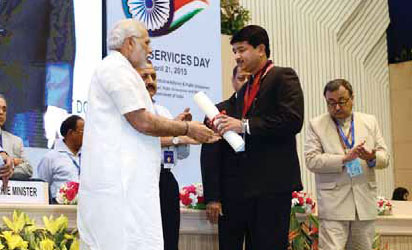 Name of the Initiative
Name of the Initiative
Saving the Womb-An Initiative to address and redress malpractices in the implementation of RSBY in Samastipur, Bihar
Name of the Awardee
Kundan Kumar
District Magistrate, Samastipur, Bihar
Project in Brief
The project aimed to address and redress malpractices in the implementation of Rashtriya Swastha Bima Yojana (RSBY) in Samastipur district of Bihar. An alarmingly high percentage (61 per cent) of hysterectomies in the district was a cause of concem. A detailed and scientific inquiry was undertaken to investigate allegations of malpractices in the implementation of RSBY. This led to revelation of physical and mental exploitation of gullible rural women by cheating them into unwanted uterus removal surgeries to make quick money.
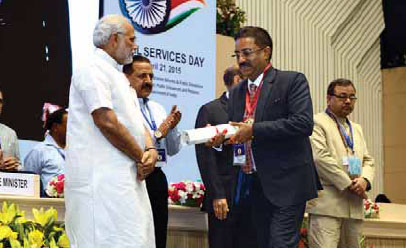 Highlights
Highlights
-
- Creation of multi-tier teams at various levels to reach out to each of the beneficiaries involved.
- Detailed case-by-case inquiry by teams of doctors and administrators.
- District-level medical camp held to conduct a medical inquiry on 2,606 women.
- Legal and definitive action against all defaulting hospitals.
Impact
-
- The nominee initiated a medico- legal investigation by reaching out to more than 5,000 beneficiaries. The medico-legal investigation included inter alia a five-day medical camp, in-camera hearing of victims, and documentation of records running into thousands of pages, a quasi-judicial proceeding against erring clinics leading to de-empanelment of clinics and lodging of FIR against them.
- The initiative created a lot of awareness about reproductive healthcare of these rural women and their vulnerability to such malpractices in the guise of social welfare schemes. It led to greater sensitisation and awareness not only among the 5.5 lakh families living under BPL of Samastipur district but in the entire country.
- Instructions were issued to the OMs of the state to carry out similar investigations in implementation of RSBY in their districts.
- Pre-authorisation was made mandatory for hysterectomy of women below 40 years of age. This led to a check in the wanton hysterectomy taking place across the state.
- Government of India introduced the categorisation clause in the empanelment of hospitals to weed out clinics with substandard physical and human resources. The approval of the District Core Committee headed by the district magistrate was made mandatory for the empanelment of health facilities under the scheme.
- The empanelment of public hospitals provided a credible alternative to the beneficiary. The empanelment of public hospitals led to flow of funds to the hospitals which was used for upgradation of infrastructure and incentivising doctors and paramedicals of the government system.
- The premium bid by the insurance providers after the initiative saw steep decline which meant saving of huge money for both the Centre and the state.
Name of the Initiative
Emotional Drive Campaign, Valsad and Vapi, Gujarat
Name of the Awardee
Dr Vikrant Pandey
Collector and District Magistrate, Valsad, Gujarat
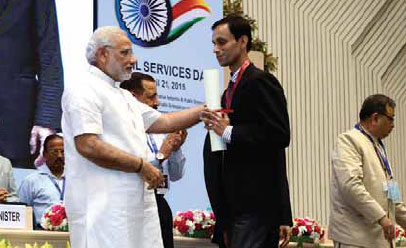 Project in Brief
Project in Brief
Valsad is a tribal district where two talukas-Kaprada and Dharampur-are quite backward. As per the 2011 census, 55 per cent of the district’s population is tribal and 2.6 per cent is Scheduled caste. The BPL population of the district is 37 per cent. After the 2006 Forest Rights Act, a large number of user rights of forest land cases was pending in the district. Under the campaign, the following three categories of action were taken.
-
- User rights of forest land
- Social Security Scheme
- Parichay Sammelan for differently abled
Highlights
Transparency and stakeholder participation
All beneficiaries were present at the site to receive the user rights of forest land and certificates were distributed at a single location at the same time in the presence of the chief minister.
Red tapism from the system was thus eliminated and in a small time period, the benefits were delivered directly to the beneficiaries.
Innovativeness of the initiative and its replicability
Following this initiative, all the cases of FRA which were pending since long years have been successfully cleared and land allotted.
Delivery was done to all beneficiaries based on a single site. The largest “Parichay Sammelan for differently abled” (deaf, dumb and blind) was held at Vapi. With Emotional Drive Campaign people connected directly with the government, resulting in lower resentment, and less number of andolans and dharnas.
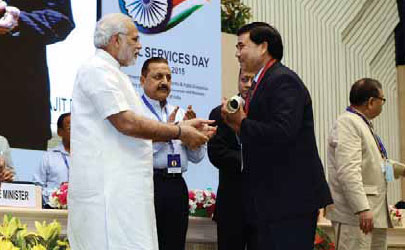 Impact
Impact
Greater transparency was achieved in administration for all beneficiary programmes of the government. Red tapism was removed, thus narrowing the gap between the government and the public.
Land planning was done by the Agriculture and Horticulture Department for tribal people who got user rights of forest land under the FRA. It has increased the productivity of tribal farmers and made a huge difference in the socio-economic conditions of the tribal people. They now also get personal and medical benefits from the government. Provision of land user rights of forests is a onetime, life-changing event for small and marginal farmers. Based on this resource, they are now able to generate livelihood, raise other resources and support their family members.
The campaign was a basket of activities, including disbursement of forest land rights to 17,204 individuals, 100 per cent financial inclusion and covering 100 per cent pension schemes to eligible beneficiaries. There was improvement in delivery time of services and better feedback from beneficiaries. Improvement in measurable indicators and simplifed procedures were other important outcomes.
Name of the Initiative
Jashn-e-Jamhuriat: Reasi-Celebrating Democracy (election project for combatting alienation and increasing inclusive electoral literacy and participation)
Name of the Awardee
Dr Shahid Iqbal Choudhary
District Collector / District Magistrate/ Distt Development Commissioner, Reasi
Project in Brief
District Reasi in Jammu & Kashmir was among 12 districts having traditionally low turnout in elections. The district recorded a dismal 43 per cent in the 2009 Lok Sabha election with participation of nomads a meagre 23 per cent and women around 33 per cent. A project was launched by the District Collector/Deputy Commissioner for reaching out to all 3,35,000 voters, convincing poll boycotters to participate in the democratic exercise, identify differently abled voters and facilitate their participation, identify the polling booth with lowest participation of women, STs, SCs and organising a scientific campaign for their participation. More than 35 campaigns and 105 activities were launched under the project and 85 partner organisations roped in for sponsorship of campaigns.
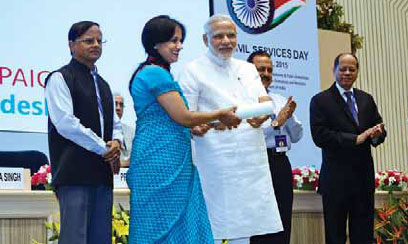 Highlights
Highlights
-
- Establishment of teams and infrastructure at village / booth level
- Building partnerships for sustainable initiative: 85 organisations
- Special programme for schools
- Electoral gram sabhas: Reinventing grassroots democracy
- Voter enrolment: mission
mode approach - Green vote plantation drive: environment & democracy-“One Sapling for one Voter”
- “JIRGA”: Mission for enrolment
of nomadic voters and their
participation - Jai Kisan Jai Hindustan campaign for electoral enrolment/ participation of farmers
- Women enrolment and their participation
- Wrestling for Nation: Sports campaign for electoral participation
- Democracy blood donation camps
- Electoral photo exhibition
- Street plays and shows
- “Rehbar” scheme for inclusion of specially abled, aged as well as infirmed voters.
- Stamps: Reaching homes-DEO’s message for electoral participation on documents
- Language: awareness mission
- Youth Parliament: Linking youth
- Campaign through letters, SMS, postcards
- Polling booth campaigns
- Polling station adoption: “Apna Booth Campaign”
- Targetted campaign for identified polling booths for inclusion
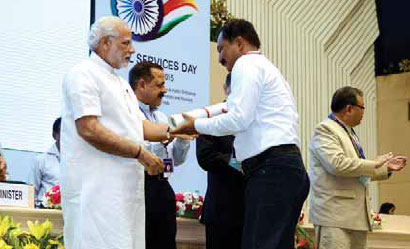 Impact
Impact
The results of the project in this militancy-infested district are a national record, with turnout increasing from 43 per cent to 81 per cent, women’s participation up from 33 per cent to 79 per cent, participation of nomads up from 23 per cent to 80 per cent and setting up of permanent structures of 301 polling booth area teams to strengthen democracy. The Election Commission of India has rated the project as exceptional and extraordinary, as an example for others in the country to replicate.
Name of the Initiative
Surguja Fulwari Initiative, Chhattisgarh
Name of the Awardee
R Prasanna
Collector & District Magistrate, District Surguja, Chhattisgarh
Project in brief
The Integrated Child Development Scheme (ICDS) is the main national programme on nutrition. Its resources, however, are focused more on children in the age group of 3-6 years. For pregnant women and under-3 children, ICDS mainly provides Take Home Rations (THR) which is not adequate to address the gaps in dietary diversity and daycare.
Surguja Fulwari Initiative is an innovation to set up community-managed child nutrition-cum-daycare centres called Fulwaris.
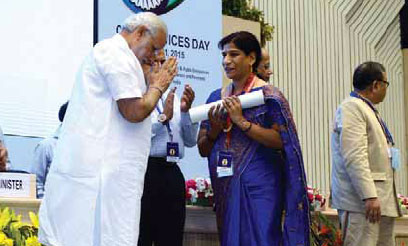 Highlights
Highlights
-
- Tribal habitations with higher levels of deprivation and malnutrition were prioritised for starting Fulwari centres. Those habitations were selected where the local community resolved to run a Fulwari centre by contributing voluntary time for childcare. Gram panchayats and Community Health Workers called Mitanins worked together for mobilising the communities. The Zilla Panchayat provided a grant (average Rs. 50,000 per annum) to mothers’group in selected habitation to run the Fulwari.
- Children aged 6 months to 3 years and pregnant and lactating women come to Fulwari and receive three hot cooked meals daily. Egg, green vegetables and oil form some of the key components of food in the Fulwari. Every day, two of the mothers volunteer their time to cook and take care of children. The space is contributed by any willing member of the community. The grant from the Zilla Panchayat is mainly used by the mothers’ group for buying rations and vegetables. By their active involvement in running the Fulwari, mothers also learn more about child feeding and hygiene. They are also trained to grow kitchen gardens, backyard poultry, fruit trees, etc., in their homesteads.
- Fulwari is an innovative initiative which does not appoint any new worker nor does it need any new infrastructure and yet is able to provide nutrition and daycare services for young children. It is a sustainable model which spends government funds directly on food for children and pregnant women and not on paying more workers. The biggest advantage is that there is hardly any gestation period in starting the Fulwari since no recruitment (of staff) or construction (of building) is involved.
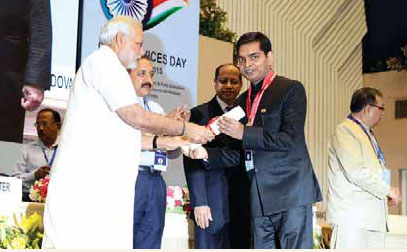 Impact
Impact
Mothers’ groups have managed to run nearly 300 Fulwari centres for almost a year now with their voluntary efforts. Around 3,500 children and 600 pregnant women have benefited from the project. The initiative has succeeded in involving panchayats in addressing malnutrition. The knowledge of mothers has also improved in terms of childcare practices.
A significant drop in the measurable indicators of child malnutrition, morbidity and mortality has been recorded.
Name of the Initiative
Revival of Sasur Khaderi-2 Rivulet and its Origin, Thithora Lake in Fatehpur District, UP
Name of the Awardees
Kanchan Verma
Special Secretary, Government of UP
Harish Chandra
District Development Officer
Kaptan Singh
Executive Engineer
Arvind Kumar
Executive Engineer
Project in Brief
The project began with Sasur Khaderi which originates from a lake in Thithora village and then carves out its course through four blocks of the district. The total distance the river covers is 46 km before it falls into the Yamuna. This river is the drainage for many small and big drains and rivulets. Under the project, a 38-km stretch of river Sasur Khaderi and its origin, Thithora Lake in district Fatehpur, were recreated and rejuvenated under MNREGS generating 2,04,900 man-days of employment in a record 45 days and the dead water bodies were brought back to life.
The initiative sought to tackle acute water crisis in the dry season and the problem of water-logging during rains by way of revival, restoration and rejuvenation of the rivulet. It recreated water storage capacity in an area of 7.377 hectares and also improved ground water recharge together with flood mitigation during rains. At the same time, the project aims at preventing the soil from turning sodic and infertile.
Meetings were held at all the four block headquarters to request the pradhans to support this mission and motivate labourers to come to the work site. BDOs had village-level meetings at every village along the river. Meetings were held with college principals, industries, social workers and media so that the objectives of the mission could be propagated.
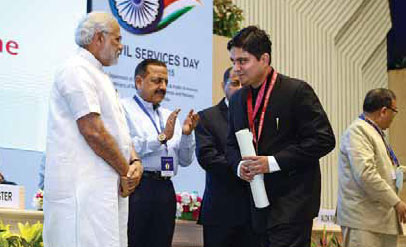 Highlights
Highlights
-
- Meticulous planning
- Convergence approach
- Qunet model
- Making it a people’s project
- Maximising the output
- Care for labour
- Close monitoring
Impact
-
- Hydraulic parameters: Post-initiative discharge on July 16, 2013 was measured as 689.95 cusecs compared to almost nil in the previous years. Similarly dead storage in the lake on June 15, 2013 was measured at approximately 15,000 cubic metres.
- Employment generation: There were 2,04,900 person-days generated in 45 days raising the district average from 30 to 90 man-days per year.
- Mitigation of floods and water-logging: No water-logging occurred in the catchment areas of the water bodies during the heavy rainfall of 2013 which was a common feature in previous years in similar situations.
- Improvement in environment: Plantation was done on the lake boundary and rivulet banks to add to the environmental quotient of the area. As a result, soil will be saved from turning sodic and infertile due to water-logging. The lake site will also provide a habitat for diverse flora and fauna and a destination for migratory birds.
Name of the Initiative
Achieving Total Financial Inclusion in West Tripura District through e-ROR (e-Record of Ordinary Residence) & Common Service Centres piloted at Mandwi block
Name of the Awardees
Abhishek Singh Distt Magistrate & Collector, Tripura
Gitte Kiran Kumar Dinkarrao
Pramod Kumar Pal
Manohar Bishwas
Pradip Roy
Project in Brief
To achieve Total Financial Inclusion in West Tripura district. an initiative was launched in tribal-dominated Mandwi block in coordination with banks, common services centres, panchayati raj institutions and NIC through tracking and identifying uncovered families as per e-ROR (e-Record of Ordinary Residence) and bringing them under banking facilities through brick and mortar branches and branchless banking (CSCs/ USBs) in remote areas. Now 100 per cent coverage has been achieved with CBS accounts and most of the benefits are now routed through bank accounts only. The initiative is being replicated in other blocks as well in the year 2014-15.
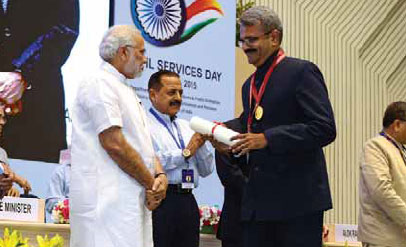 Highlights
Highlights
-
- 100 per cent coverage of all families with CBS accounts
- Opening of four Common Service Centres (USBs) and two ATMs, and 20 USBs in entire district
- Seeding of accounts in the e-ROR and maintenance of database
- GIS-based mapping for opening of new bank branches and USBs
- Rolling out of Electronic Fund Management System (EFMS)
- Doorstep service delivery through Business Correspondents
- Linking of benefits like payment under MNREGS, lAY, NSAP, NBA, JSY, JSSK, etc
- Availing of the credit facilities in priority sectors
Impact
-
- All families were covered with CBS bank accounts
- Extension of branchless banking through 20 USBs
- Electronic transfer of benefits under MNREGS, lAY, JSY, etc
- 220 per cent increase in credit in the agriculture and allied sectors in two years
- Seeding of the accounts in the databases of schemes and banks
- Suitable platform to achieve objectives of PMJDY by October/ November, 2014
Name of the Initiative
LADO (An innovative initiative for eradicating child marriages)
Name of the Awardees
JN Kansotia, Principal Secretary, Government of Madhya Pradesh
Kalpana Srivastava
Rekha Sharma
Harish Khare
Arvind Singh Bhal
Tini Pandey
Sushil Kumar Verma
Project in Brief
The LADO campaign has been initiated by the Directorate of Women Empowerment, Government of Madhya Pradesh, for creating an environment for eradicating child marriage in the state. It is designed with a view to sensitise and train the community about the consequences of child marriage.
The LADO campaign has the following four components:
- Community sensitisation
- Training of core group members
- Promotional campaign
- Prevention of child marriage
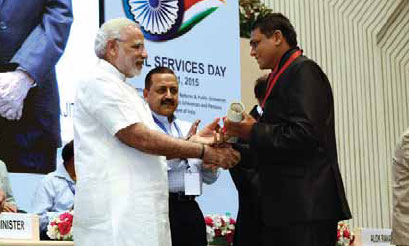 Highlights
Highlights
- Constitution of a core group in each village/ward for prevention of child marriages
- Focus on sensitisation of the community for creating an enabling environment
- Focus on those areas and districts where incidence of child marriage is high
- Enhancing capacities of the core group members
- Promotional campaigns through radio jingles, television scrolls, television talk shows, film broadcasting, etc
- Use of traditional methods like role play, nukkad natak for specific campaigning
- Effective use of print media through advertisement and other methods of dissemination of information like
hoardings, flex, publicity, etc
- Concurrent monitoring to ensure success in the initiative
Impact
- Over 40,000 core groups had been formed in just over one year
- In a span of one year, total 16 lakh people were sensitised by the core group through 80,000 Aanganwadi centres
- A total of 12,439 schools were covered by the core group where sensitisation programmes for children were conducted for making them aware about consequences of child marriages
- Prior to the initiative, till March 2013 only 181 child marriage functions were stopped. After initiating the LADO campaign, the number of child marriage functions has decreased remarkably
- It has been observed that Indore, Bhopal and Ujjain divisions have reported the maximum instances of child marriages and its prevention due to the inclusion of tribal districts like Dhar, Khandwa, Jhabua, Vidisha and feudal-dominated districts like Rajgarh, Ratlam, etc., where the practice is prevalent
- Evolution of 40,000 core groups with enhanced knowledge about child rights Acts
- Sensitisation of schoolchildren has led to proactive responses from their side towards the issue of child marriages
- Enhanced enrolment of children and their retention in schools
Name of the Initiative
Skill Development Program to impart vocational training to the tribal youth, Gadchiroli, Maharashtra
Name of the Awardees
Ranjit Kumar,
District Collector, Gadchiroli, Maharashtra
Abhishek Krishna
TSK Reddy
PY Deshmane
YS Shende
Project in Brief
- To increase the employability of the youth largely dependent on the primary sector, an initiative called Skill Development Program was initiated on the guidelines of the Prime Minister’s Councill for Skill Development. The Career Guidance and Counselling Centre in the district was formulated to regulate the programme under the control of the District Skill Development Executive Committee, chaired by the District Collector.
- The unemployed/ underemployed youth undergo counselling at the village level which is followed by an entrance examination in the form of an aptitude test and personal interview. This helps in determining a suitable trade as per the ability and inclination of the selected candidates. So far the candidates were trained in three domains, viz., hospitality, construction and automobile, This year onwards, the CGCC is planning to scale up and include 13 more disciplines.
- The concept is to identify youth to whom quality skill development training could be imparted, which would help to bridge the unemployment vs. labour deficiency gap. Apart from providing consistent and sustainable source of income, the programme is also assisting in reducing disguised unemployment in the agriculture sector.
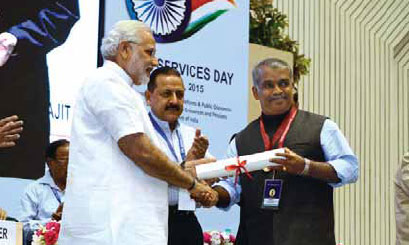 Highlights
Highlights
- Higher grassroots coverage through counsellors.
- Selection of candidates through examination and interview which helps to identify the trade that is suitable for the selected candidate as well as the market demand for such trade.
- Training and transportation charges are directly borne by the district administration while expenditure on food and accommodation is done by the institute which is reimbursed after completion of training. There is no cost to the candidate.
- Considering the flexibility and frequency required, a new batch is started to accommodate the requirement every month.
- In the past three years, 88 per cent of the trainees have been successfully placed, many of them in major cities and industries.
- On an average, the candidate receives Rs. 8,500 per month along with job availability round the year.
Impact
In the past three years, the programme has shown promising success in terms of the number of candidates joining the programme as well as the placements that have been secured. Candidates who have succeeded in achieving placements through this initiative are now assisting the programme publicity. There is a high degree of convergence and inter-department coordination in terms of outreach of the programme.
Name of the Initiative
Eraviperoor Grama Panchayat-Success Story of Local Self-Governance
Name of the Organisation
Eraviperoor Grama Panchayat, Kozhimala P.O, Thiruvalla, Pathanamthitta District, Kerala
Project in Brief
The project achieved a paperless and modern office at Eraviperoor panchayat with a Village Knowledge Centre, Environment Gram Sabha, waste management , a mini water supply scheme, Arogya Sabha, Jagratha Samithy, etc.
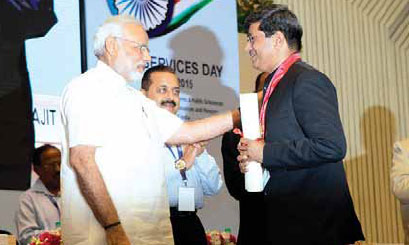 Highlights
Highlights
1. Paperless Office
a. Online certificates
b. Digitalisation of office records
c. Notices and information through voice and text messages
d. Salary of employees and honorarium or board members through bank
e. Tracing of records and documents within five minutes
f. Touchscreen facility to trace the file movement and information
g. All sections of the office, including Front Office, networked
h. Installation and application of 12 softwares developed by Information Kerala Mission.
- Village Knowledge Centre : Activities include a reference library; training for school students for civil services and other competitive examinations; classes in Sanskrit, etc.; preparing a directory of history, cultural and the traditional knowledge of the village.
- Environment Gramasabha : Special gram sabha set up in all wards to create awareness on environment issues and waste management. Also, 20,000 seedlings were distributed to gram sabha participants
- Waste Management : Under this programme, activities undertaken included distribution of biogas plant, vermi-pipe-ring compost units; plastic recycling unit; plastic road; compost pit; modern slaughterhouse; modern fish market; and setting up of a ward committee giving importance to ecology
- Mini Water Supply Scheme : Eight schemes have been completed under SC/ST plan fund while two schemes under general fund and two schemes under SC/ST plan fund are nearly complete
- Arogya Sabha : Yoga classes held at eight centres; Ayush sub-centres and a yoga centre started at Primary Health Centre Compound; karate classes for 105 girl students; renovation of Primary Health Centre building; pain and palliative care; and insurance coverage for cancer treatmentImpact
The positive changes brought about by the initiative are appreciated by the people and a survey shows the quality of the service has improved.It is an experiment in good governance to ensure the well-being and good livelihood of the people of the panchayat. The completion of the implementation of each of the projects results in better growth.Name of the Initiative
Canal Top Solar Power Plant-A New Direction to Green and Clean EnergyName of the Organisation
Gujarat State Electricity Corporation Ltd (GSECL)Project in Brief
Given the need to economise use of fast-depleting energy sources like coal. oil, gas, etc., and increasing awareness about the importance of green and clean energy, the Gujarat government introduced the Solar Policy 2009. This project exploits Solar Urjashakti with Jalshakti while saving land and conserving water by reducing evaporation.Highlights
The site for the project was selected after scientific study. Minimisation of the transmission loss led to strengthening of the grid. Latest technology was used for monitoring of the plant. The project was commissioned within six months.Impact
Generation of 3,935 MW of green energy during the period February 2012 to August 2014 (30 months). About 3,770 tonnes carbon emission saved till August 31, 2014. Saving of nine million litres/MW of water/year. Development of surrounding area with greenery. As the project is fully replicable, further projects with higher generation capacity are being planned in the state, on the existing Narmada main as well as branch canal. Employment opportunity for minimum 10-15 persons, unskilled, semi-skilled and skilled, depending on length of canal.































































